Page 10 of 386
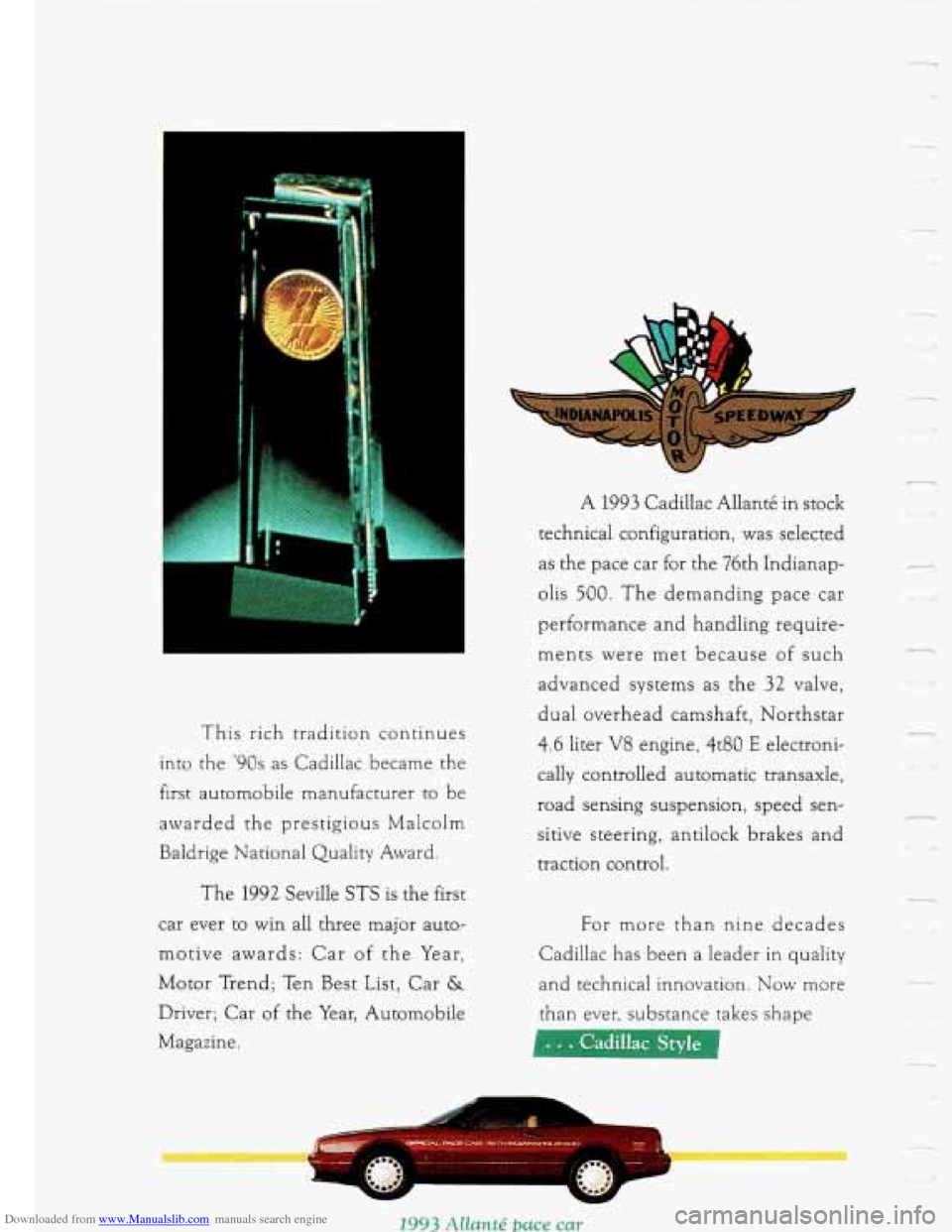
Downloaded from www.Manualslib.com manuals search engine This rich tradition continues
into the
‘90s as Cadillac became the
first automobile manufacturer to be
awarded the prestigious Malcolm
Baldrige National
Quality Award.
The
1992 Seville STS is the first
car ever to win all three major auto-
motive awards: Car of the Year,
Motor Trend; Ten Best List, Car
&a
Driver; Car of the Year, Automobile
Magazine.
V
A 1993 Cadillac AllantC in stock
technical configuration, was selected
as the pace car for the 76th Indianap-
olis
500. The demanding pace car
performance and handling require-
ments were met because
of such
advanced systems as the
32 valve,
dual overhead camshaft, Northstar
4.6 liter V8 engine, 4t80 E electroni-
cally controlled automatic transaxle,
road sensing suspension, speed sen-
sitive steering, antilock brakes and
traction control.
For more
than nine decades
Cadillac has been
a leader in quality
and technical innovation. Now more
than ever, substance takes shape
1
c_q
7,
U
Page 98 of 386
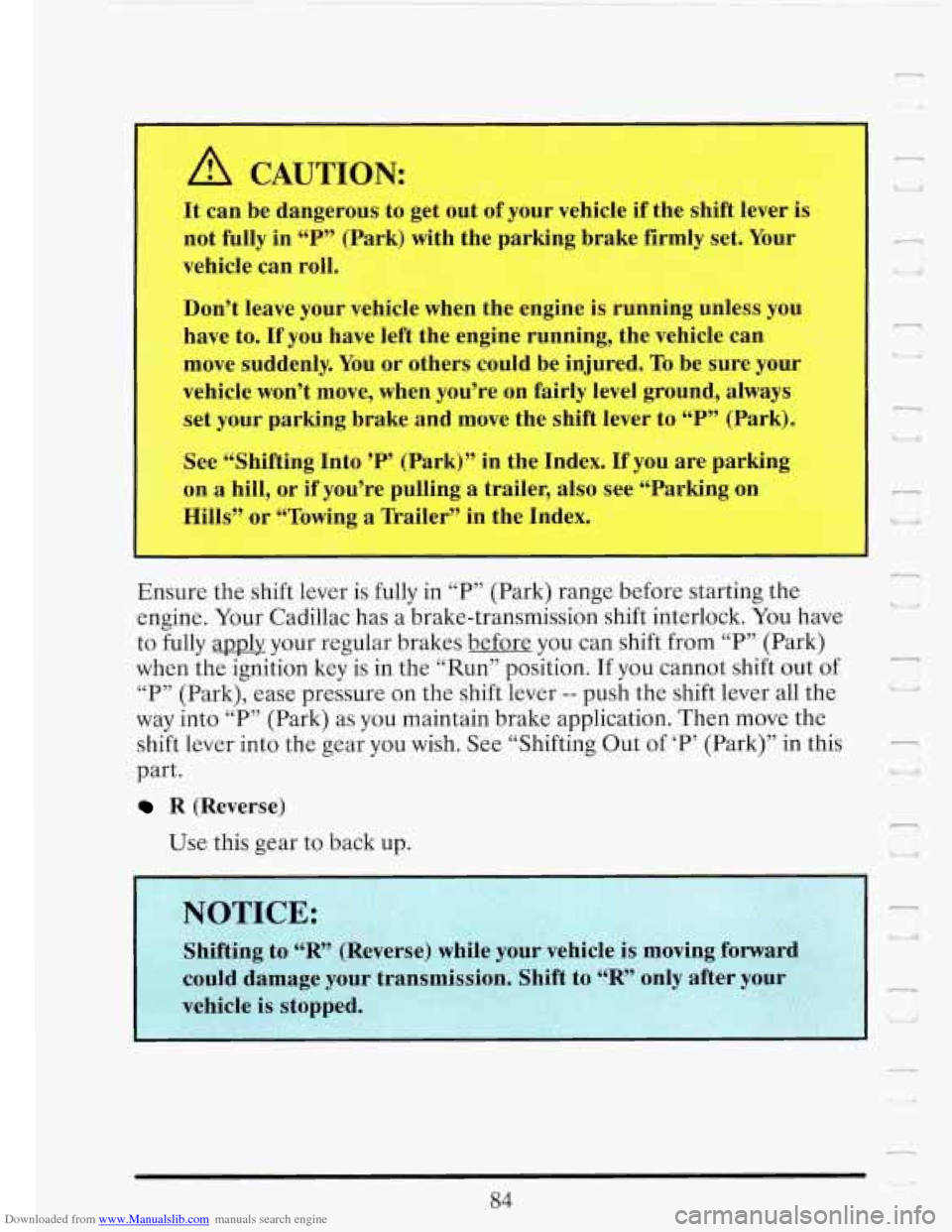
Downloaded from www.Manualslib.com manuals search engine A CAUTION:
It can be dangerous to get out of your vehicle if the shift lever is
not fully
in “P” (Park) with the parking brake firmly set. Your
vehicle can roll.
Don’t leave your vehicle when the engine is running unless
you
have to. If you have left the engine running, the vehicle can
move suddenly. You or others could be injured.
To be sure your
vehicle won’t move, when you’re on fairly level ground,
always
set your parking brake and move the shift lever to “P” (Park).
See “Shifting Into ’P’ (Park)” in the Index. If you are parking
on
a hill, or if you’re pulling a trailer, also see “Parking on
Hills’’ or “Towing a Railer” in the Index.
Ensure the shift lever is fully in “P” (Park) range before starting the
engine. Your Cadillac has a brake-transmission shift interlock. You have
to fully apply your regular brakes before you can shift
from “P” (Park)
when the ignition key
is in the “Run” position. If you cannot shift out of
“P” (Park), ease pressure on the shift lever
-- push the shift lever all the
way into “P” (Park) as you maintain brake application. Then move the
shift lever into the gear you wish. See “Shifting Out of
‘P’ (Park)” in this
part.
R (Reverse)
Use this gear to back up.
I
ha
1 UI
r
.i
I 4
84
‘- I
Page 100 of 386
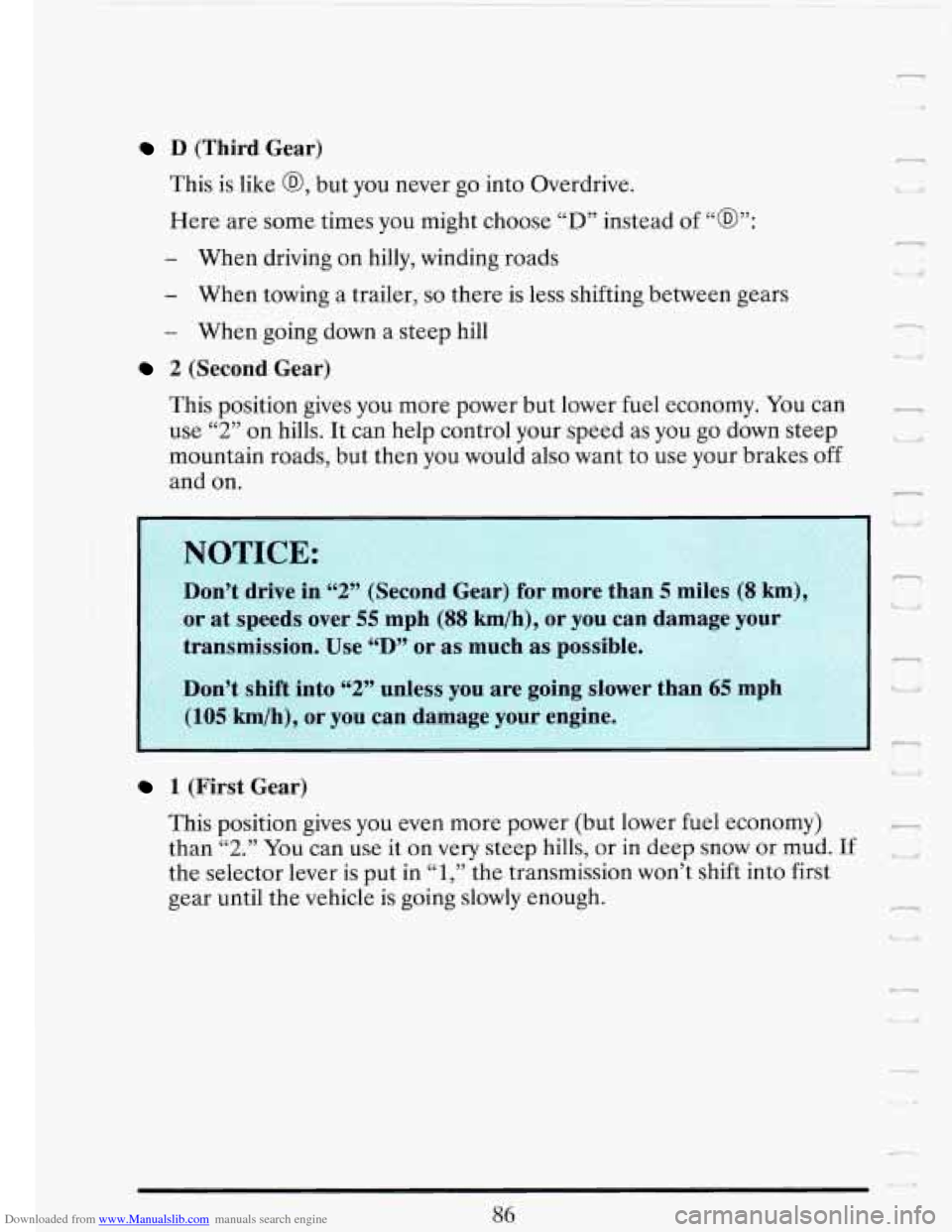
Downloaded from www.Manualslib.com manuals search engine D (Third Gear)
This is like
@, but you never go into Overdrive.
Here are some times you might choose
“D” instead of “a”:
- When driving on hilly, winding roads
- When towing a trailer, so there is less shifting between gears
- When going down a steep hill
2 (Second Gear)
P
bl ia
This position gives you more power but lower fuel economy. You can -
use 2 on hills. It can help control your speed as you go down steep
mountain roads, but then you would also want to use your brakes
off
and on.
cc 97 ,>
NOTICE:
Don’t drive in “2” (Second Gear) for more than 5 miles (8 km),
or at speeds over 55 mph (88 km/h), or you can damage your
transmission. Use “D” or as much
as possible.
Don’t shift into
“2” u are going slower than 65 mph
(105 km/h), or you can damage your engine.
1 (First Gear)
I-
This position gives you even more power (but lower fuel economy) r
than “2.” You can use it on very steep hills, or in deep snow or mud. If I
the selector lever is put in “1,” the transmission won’t shift into first
gear until the vehicle is going slowly enough.
- I,
U
-.
L.
86
Page 101 of 386
Downloaded from www.Manualslib.com manuals search engine r
NOTICE:
If your rear wheels can’t rotate, don’t try to drive. This might
against
a solid object. You could damage your transmission.
- happen if you were stuck in very deep sand or mud or were up
Also, if you stop when going uphill, don’t hoh’
with only the accelerator pedal. This could
01
damage the transmission. Use your brakes ta
in position on a hill.
I. 1 ..
-
- I
LOCHNG DIFFERENTm REAR AXLE
If you have this feature, your rear axle can give you additional traction on
snow, mud, ice, sand or gravel. It works like a standard axle
most of the
time, but when one
of the rear wheels has no traction and the other does,
the locking feature
will allow the wheel with traction to move the vehicle.
PmNG BRAKE
-
The parking brake uses the brakes on the rear wheels.
Page 117 of 386
Downloaded from www.Manualslib.com manuals search engine CRUISE CONTROL
With Cruise Control, you can maintain a speed of about 25 mph (40
km/h) or more without keeping your foot on the accelerator. This can
really help
on long trips. Cruise Control does not work at speeds below
about
25 rnph (40 km/h).
When you apply your brakes, the Cruise Control shuts
off.
A CAUTION:
Cruise Control can be dangerous where you can’t drive safely
at a steady speed.
So, don’t use your Cruise Control on
winding roads or in heavy traffic.
0 Cruise Control can be dangerous on slippery roads. On such
roads, fast changes in tire traction can cause needless wheel
spinning, and you could lose control. Don’t use Cruise
Control on slippery roads.
103
Page 184 of 386
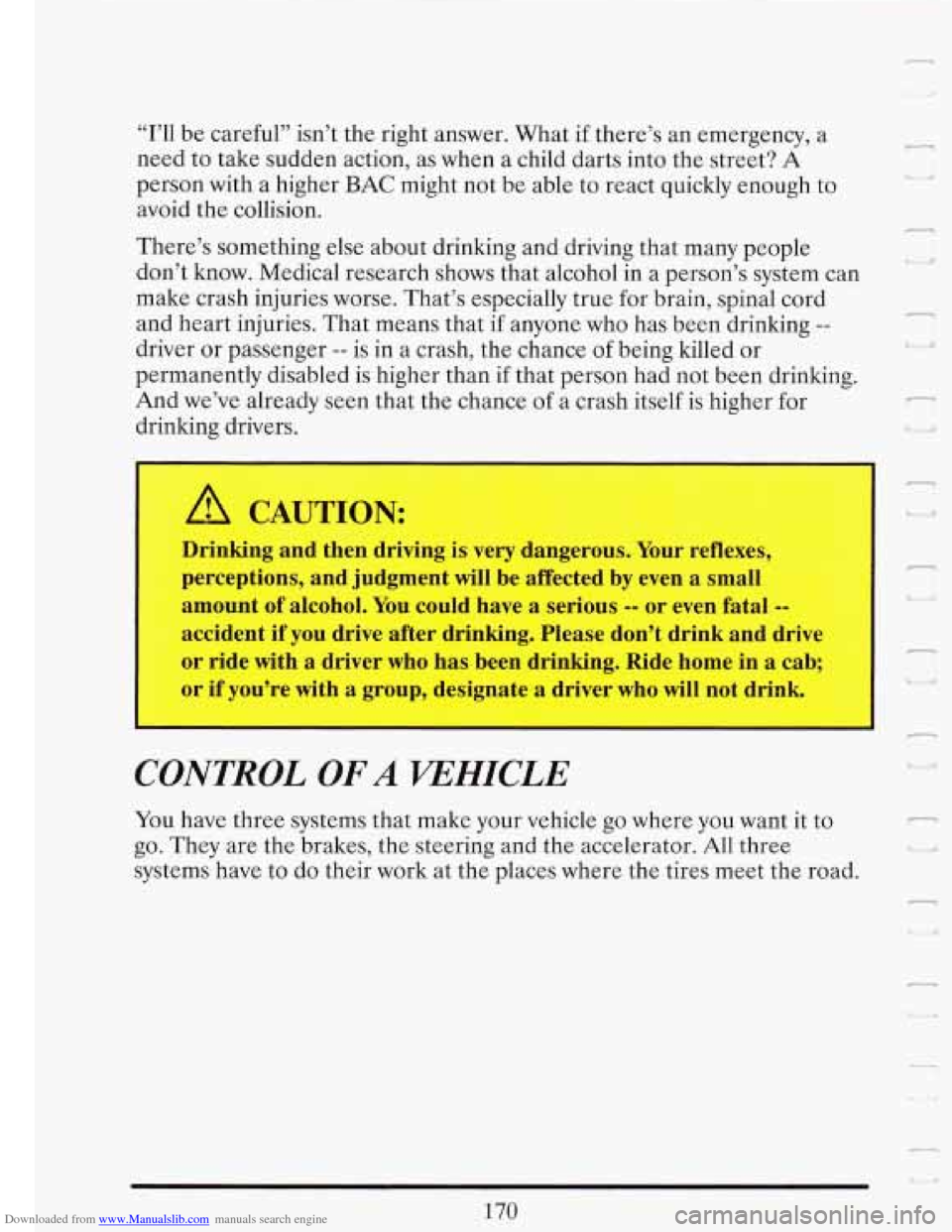
Downloaded from www.Manualslib.com manuals search engine “I’ll be careful’’ isn’t the right answer. What if there’s an emergency, a
need to take sudden action, as when a child darts into the street?
A
person with a higher BAC might not be able to react quickly enough to
avoid the collision.
There’s something else about drinking and driving that many people
don’t know. Medical research shows that alcohol in a person’s system can
make crash injuries worse. That’s especially true for brain, spinal cord
and heart injuries. That means that
if anyone who has been drinking --
driver or passenger -- is in a crash, the chance of being killed or
permanently disabled is higher than
if that person had not been drinking.
And we’ve already seen that the chance of a crash itself is higher for
drinking drivers.
A CAUTION:
Drinking and then driving is very dangerous. Your reflexes,
perceptions, and judgment will be affected by even a small
amount of alcohol. You could have a serious
-- or even fatal --
accident if you drive after drinking. Please don’t drink and drive
or ride with
a driver who has been drinking. Ride home in a cab;
or if you’re with a group, designate a driver who will not drink. I
CONTROL OF A VEHICLE
You have three systems that make your vehicle go where you want it to
go. They are the brakes, the steering and the accelerator.
All three
systems have to do their work at the places where the tires meet the road.
11
d
a ,’ d
170
Page 185 of 386
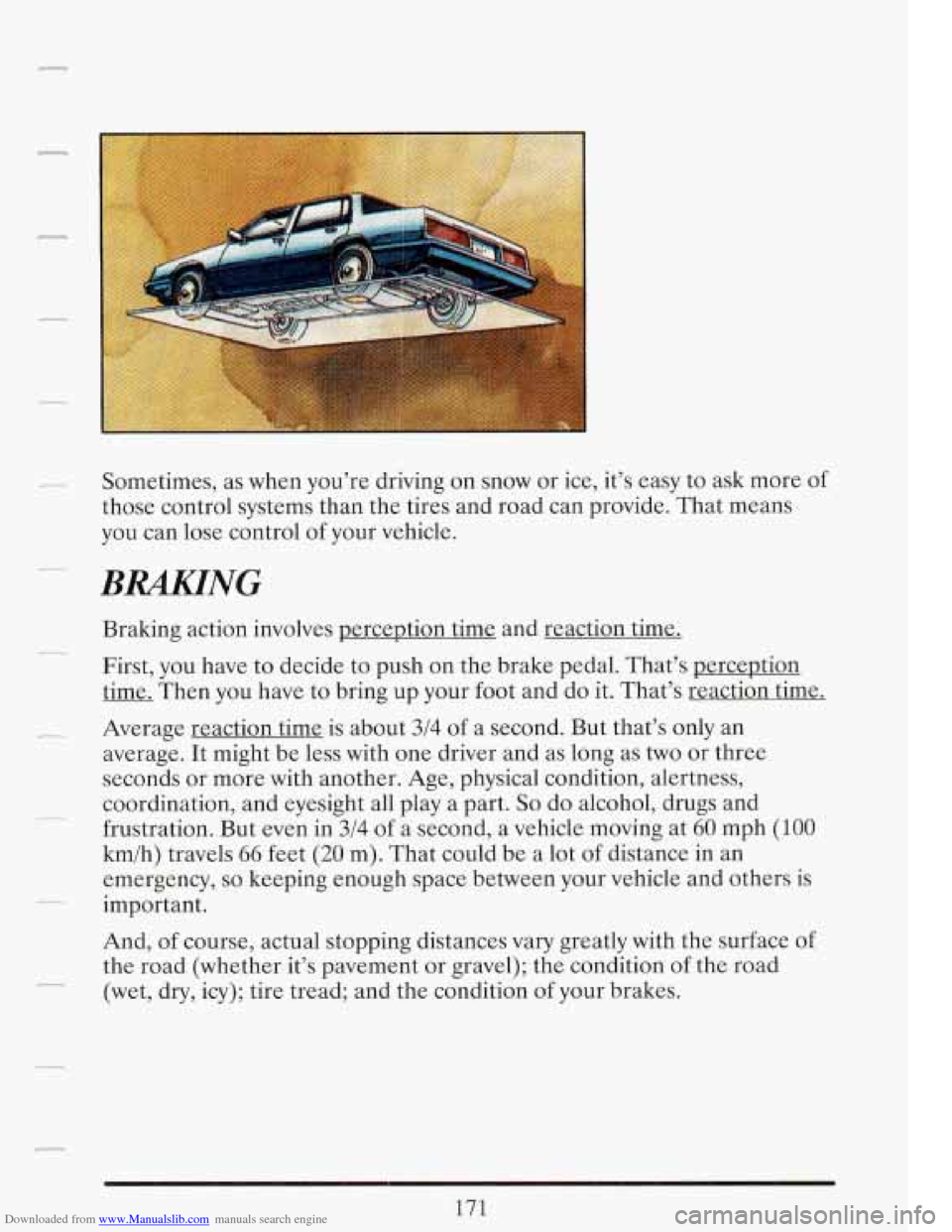
Downloaded from www.Manualslib.com manuals search engine Sometimes, as when you’re driving on snow or ice, it’s easy to ask more of
those control systems than the tires and road can provide. That means
you can lose control
of your vehicle.
BWNG
Braking action involves perception time and reaction time.
First, you have to decide to push on the brake pedal. That’s perception
time. Then you have
to bring up your foot and do it. That’s reaction time.
Average reaction time
is about 3/4 of a second. But that’s only an
average. It might be less with one driver and as long as two or three
seconds or more with another. Age, physical condition, alertness,
coordination, and eyesight all play a part.
So do alcohol, drugs and
frustration. But
even in 3/4 of a second, a vehicle moving at 60 mph (100
km/h) travels 66 feet (20 m). That could be a lot of distance in an
emergency,
so keeping enough space between your vehicle and others is
important.
And, of course, actual stopping distances vary greatly with the surface
of
the road (whether it’s pavement or gravel); the condition of the road
(wet, dry, icy); tire tread; and the condition of your brakes.
171
Page 186 of 386
Downloaded from www.Manualslib.com manuals search engine Most drivers treat their brakes with care. Some, however, overwork the
braking system with poor driving habits.
Avoid needless heavy braking. Some people drive in spurts -- heavy
acceleration followed by heavy braking
-- rather than keeping pace
with traffic. This is a mistake. Your brakes may not have time to cool
between hard stops. Your brakes will wear out much faster
if you do a
lot of heavy braking.
Don’t “ride” the brakes by letting your left foot rest lightly on the
brake pedal while driving.
1 A CAUTION:
“Riding” your brakes can cause them to overheat to the point
that they won’t work well. You might not be able to stop your
vehicle in time to avoid an accident.
If you “ride” your brakes,
they will get
so hot they will require a lot of pedal force to slow
you down. Avoid “riding” the brakes.
172
n
I. - . il
L